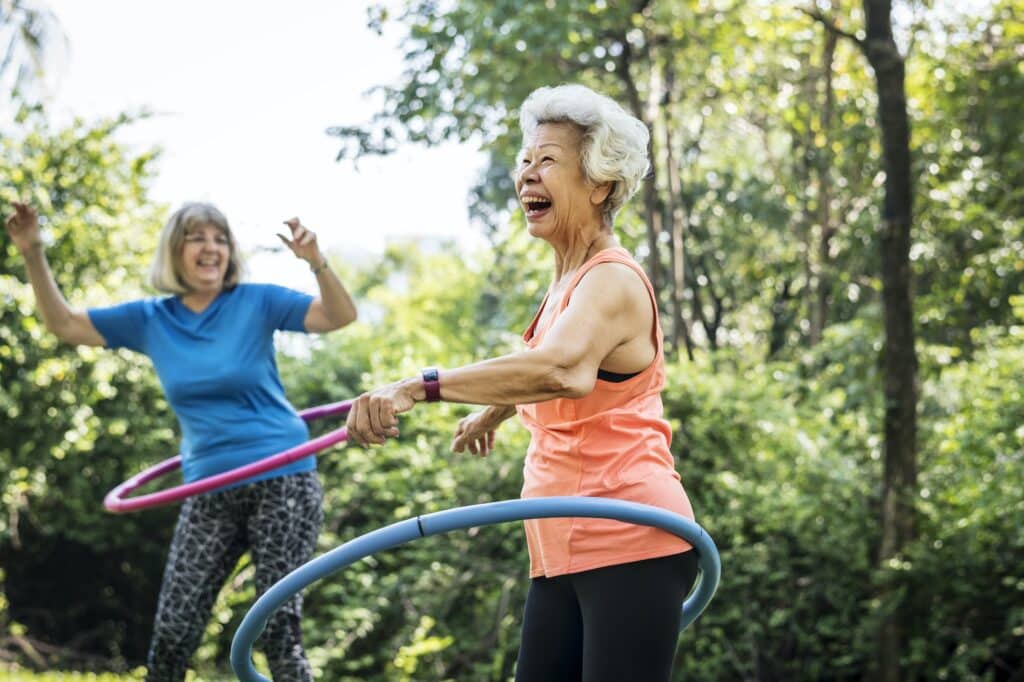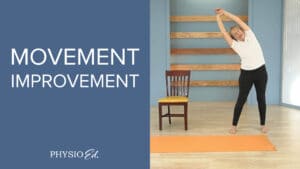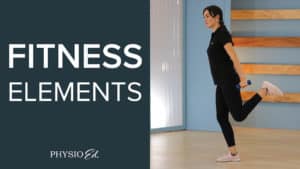If you suffer from hip pain, you are not alone. One study found that roughly fourteen percent of people over sixty reported significant hip pain on most days, while more than eighteen percent of inactive seniors reported severe hip pain in the previous month.
Hip pain can make bending, walking, putting on shoes, and other daily activities difficult. Even if you’re experiencing some of these challenges, there are many things you can do to keep your hips mobile, strong, and healthy and reduce your risk of pain in the future.
Today, we’ll explore your options and introduce some easy hip exercises for seniors to avoid hip pain.
Maintaining Healthy Hips
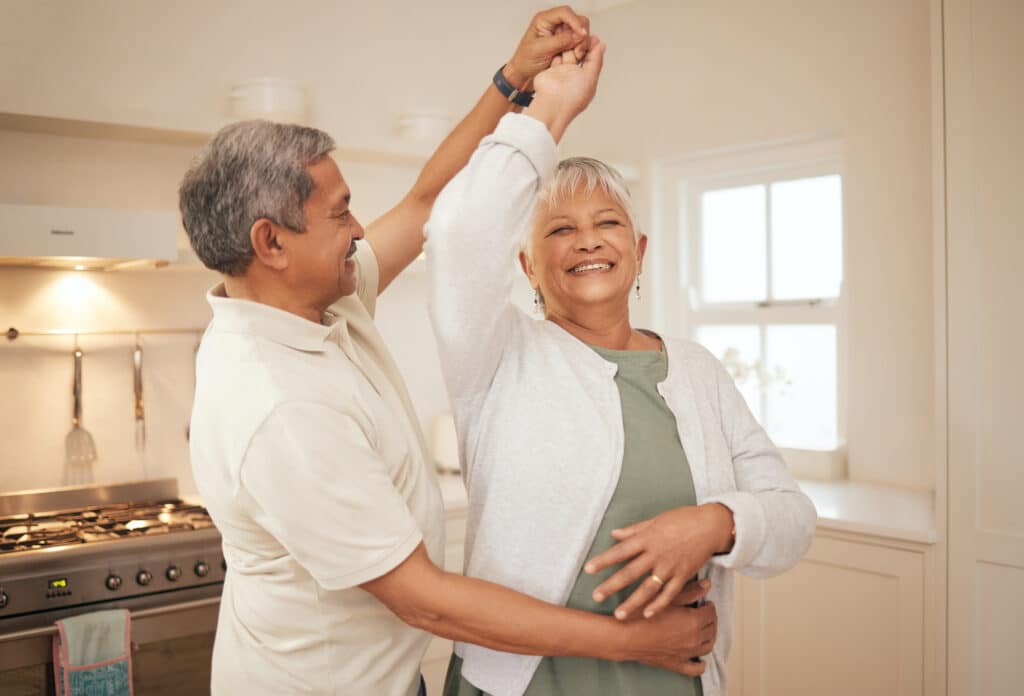
Pain and dysfunction may result from several problems, including osteoarthritis, osteoporosis, bursitis, nerve impingement, or recent injury (such as falls or hip fractures) at the hip joint.
Focusing on hip health early can help reduce the risk of pain and problems in the future. Body weight management, exercise, and a diet prioritizing strength and bone health are all important factors to consider when building healthy hips.
Let’s examine some steps you can take to reduce hip pain in your daily life and some hip-strengthening exercises to keep you feeling strong and healthy.
Note: If you are in severe pain, it may be best to consult with a health care provider, such as a physical therapist or your doctor, to best address your condition before you follow this or any other exercise advice.
Body Weight Management
Being overweight can negatively affect joint health, especially in the joints that support weight, such as the back, hips, and knees.
Managing or losing weight can be one of the best strategies to keep your joints healthy.
Staying active with fun exercises is a great way to help manage your weight. Exercises that increase your heart rate, such as walking, hiking, or biking, can be especially beneficial for burning calories.
A healthy, balanced diet is vital for weight management. If you are trying to lose weight, focus on dietary changes that are manageable long-term.
It’s also important to note that “crash” diets– or diets that ask you to make unreasonable changes– can be unhealthy and are not typically sustainable for most people.
Heart-healthy cardiovascular exercise combined with a well-balanced and sustainable diet is an excellent way to start your journey back to hip health.
Eating Well to Prevent Joint Pain
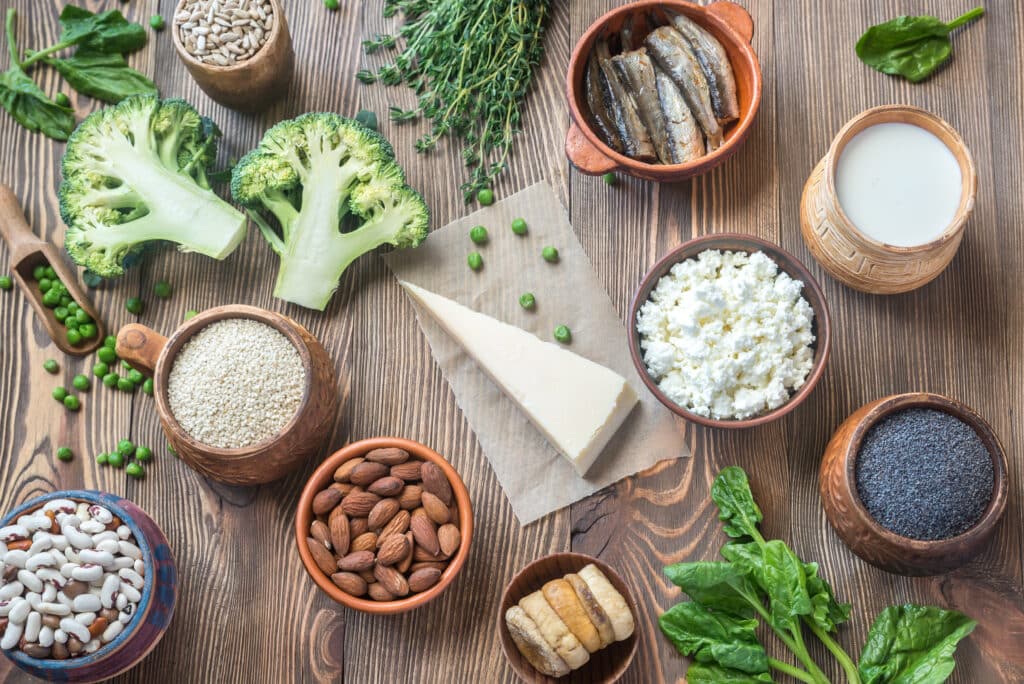
In addition to managing weight, nutrition can help by providing the building blocks for improving bone health.
Your body—and especially your bones—needs calcium. If you don’t eat enough of the mineral, your body will start breaking down bones for calcium, degrading your bone health over time.
Women over fifty should consume 1200mg of calcium daily, and men should have 1000-1200mg. Foods high in calcium include dairy products (milk, yogurt), nuts, beans, and leafy greens.
Vitamin D helps your body absorb the calcium from your diet. Sunlight is one of the greatest sources of vitamin D, but it can also be added to your diet in some foods, like salmon or vitamin D-fortified milk.
Talk with your doctor about how much vitamin D and calcium is right for you.3
What Are Weight-Bearing Activities?
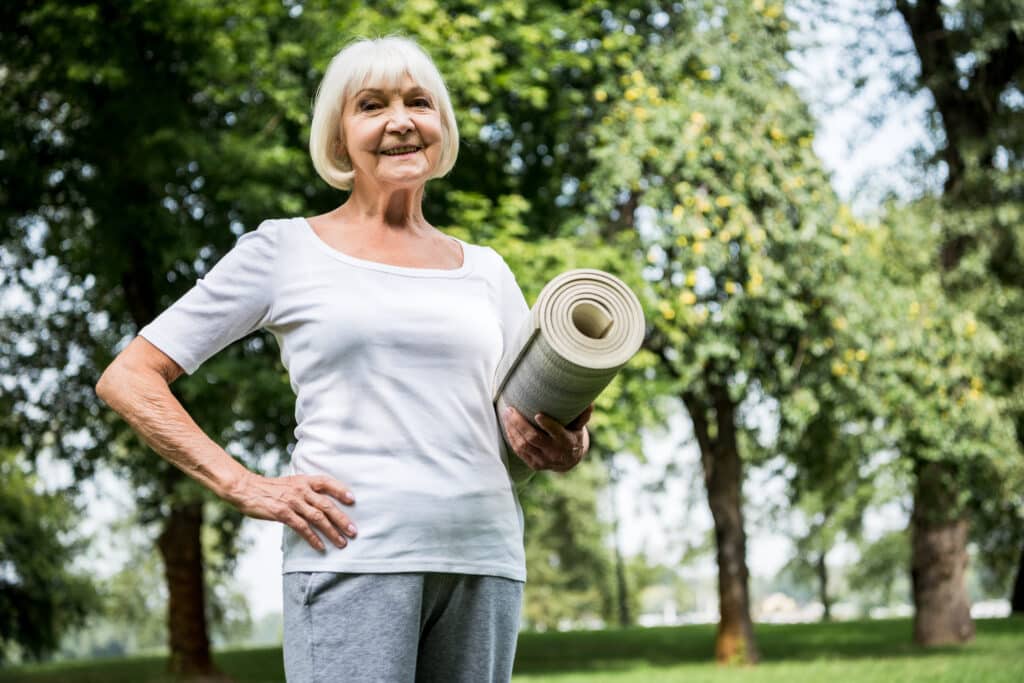
Like a muscle, bone can become stronger when challenged with weight-bearing activities or strength-building exercises. Bone density typically peaks in your thirties and can degrade with each following decade.
Strength exercise is especially important for the bones in and around your hips.
Regular bone-strengthening exercises can help to maintain and even improve bone mass. Weight-bearing activities include anything that requires you to carry weight through your arms or legs against gravity.2
This could include walking, aerobics, climbing stairs, tennis, hiking, yoga, or even dancing. Once again, it is important to choose activities you enjoy and can perform safely.
If you have already been diagnosed with osteoporosis or osteopenia, it can be best to perform low-impact activities (walking or yoga) compared to high-impact activities like running or jumping so that your bones can rebuild gradually and safely.
Healthy Hips: The Best Hip Exercises for Seniors
Hip strengthening exercises should focus on mobility, strength, and stability.
- Keeping your hips flexible helps ensure you can perform basic daily activities, like bending over or lifting your foot to put your shoe on.
- Strengthening the muscles surrounding the hip can help reduce pressure on the hip joint. Staying healthy and strong is necessary for movements like lifting grandchildren or climbing stairs.
- Finally, better balance helps reduce the risk of falls to help prevent future injuries.
Let’s look at some hip exercises for seniors to keep your hip muscles strong, flexible, and ready to move, pain-free.
Mobility Exercises for Seniors
Quadruped Rock Back
This is a warmup to activate the hip flexors and gently stretch the glute muscles and lower back.
- Start on hands and knees.
- Slowly rock your hips back as if to gently lower your hips to your heels. Keep your arms out in front of you. Hold for a few seconds then return to all fours position. Complete 10-15 times.
If you cannot kneel on your knees, an alternative would be laying on your back with your knees bent and your heels on a large yoga ball.
- Lie on your back with a cushion or yoga block under the back of your head to support your neck. Start with your legs extended, and slightly bent knees.
- Gradually roll the ball in so both knees come closer to your chest as if you are trying to bring the ball closer to you. Hold briefly then relax back to the starting position.
Hip Flexor Stretch
This is a stretch sequence for the hip flexors– the muscles in the front of your hip where you bend to sit in a chair.
- Start in a kneeling lunge position with one knee on the ground, and the other foot flat on the floor in front of you. The knee that is on the ground is the leg you will be stretching.
- Gradually shift your torso forward over your front leg until you feel a stretch around the front of the knee-down leg. Keep your abdominal core muscles engaged so you do not arch your back.
- If you cannot kneel, try this same stretch while standing in a lunge position with your back leg straight. Hold for 20-30 seconds. Complete 2-3 repetitions on each side.
Figure-Four Stretch
This is a series of hip stretches for your outer hips, thighs, and your low back.
- Start laying on your back and bend one leg so your foot is flat on the floor.
- Cross your other leg so your foot is resting on your knee.
- For a greater stretch, pick your foot up off the floor and pull it in closer to your chest while keeping the figure 4 position with the other foot.
- Alternatively, try this exercise while sitting. Cross one foot over your opposite knee. To deepen the stretch, lean forward at your waist. Hold for 20-30 seconds. Complete 2-3 repetitions on each side.
Strengthening Exercises for Seniors
Side-Stepping
This movement will help strengthen your outer hip muscles (the hip abductors), which support the stability of your hip joints.
Note: If you have balance trouble, perform this exercise along your countertop.
- Keep your hips facing the same direction as your toes and take a moderately large step to the side.
- Complete for 15 steps, then take 15 steps back to the starting point.
- To make it more challenging, try adding a resistance band around the top of your knees. Push your knees out against the resistance while side-stepping.
Clam Shell
This exercise targets the large gluteus muscles on your backside, which will help to prevent back pain and injury
- Start laying on your side with your hips and knees bent.
- Keep your feet together and lift your top leg, separating at the knees (like a clam shell opening). You should feel your outer hip muscles working.
Clam Shell With Resistance Band
- For a greater challenge, try adding a resistance band around the tops of your knees. Complete sets of 10-12 repetitions. This exercise will strengthen hip external rotation.
Reverse Clam Shell
This exercise targets the hip flexor muscles on the front-outer hip, which can often lack strength.
- Start in the same position as the last exercise.
- This time keep your knees together and separate at your feet. You can move the resistance band to your ankles to make it more challenging for this one. This exercise will strengthen hip internal rotation.
Bridge Exercise
This exercise targets hip flexibility, and strength for the glute muscles, while also strengthening the abdominal muscles and the low back.
- Lay on your back and bend both knees, placing your feet flat on the ground.
- Squeeze the muscles in your buttocks and lift your hips off the ground. Do not arch your back. Pause at the top then lower. Repeat.
Balance Exercise for Seniors
Balance can be one of the single most important styles of exercise for hip health.
Try this simple balance exercise to begin working on one of the most important hip-strengthening exercises you can do.
Single Leg Balance
- Shift your weight to one leg and gradually try to lift the other off the floor. Try to keep your pelvis level, preventing either hip from dropping. Hold for as long as you can
- For an added challenge, try holding your balance on one foot while lifting the opposite leg straight in the following directions: forward, sideways, and back.
- Be sure this is a controlled lift, not a leg swing. Imagine you are drawing a large half-circle around your body with your straight leg.
- Complete 10 repetitions in each direction before switching legs.
Key Takeaways
- Hip pain is common among seniors, with significant daily pain affecting many over sixty, especially inactive individuals.
- Common causes of hip pain include osteoarthritis, osteoporosis, bursitis, nerve impingement, and injuries such as falls or fractures.
- Managing body weight, exercising regularly, and maintaining a calcium and vitamin-D-rich diet are crucial for hip health.
- Weight-bearing activities and strength-building exercises help maintain and improve bone density, reducing the risk of hip pain.
- Mobility exercises like quadruped rock back, hip flexor stretch, and figure-four stretch can improve hip flexibility and reduce pain.
- Strengthening exercises such as side-stepping, clamshell, reverse clamshell, and bridge exercises target hip muscles to support joint stability and reduce pressure on the hip.
- Balance exercises, including single-leg balance, are essential for preventing falls and improving overall hip health.
FAQs
What are some common causes of hip pain in seniors?
Common causes of hip pain in seniors include osteoarthritis, osteoporosis, bursitis, nerve impingement, and injuries such as falls or fractures. These conditions can make daily activities like bending, walking, and putting on shoes difficult.
How can maintaining a healthy weight help reduce hip pain?
Being overweight can negatively affect your joints, including your hips. Managing or losing weight can help reduce the strain on your hip joints. Staying active with exercises like walking, hiking, or biking, and maintaining a balanced diet, are effective strategies for weight management.
What are some important nutrients for hip health?
Calcium and vitamin D are crucial for maintaining bone health. Women over fifty should consume 1200mg of calcium daily, while men should have 1000-1200mg. Foods high in calcium include dairy products, nuts, beans, and leafy greens. Vitamin D, which helps your body absorb calcium, can be obtained from sunlight and foods like salmon or vitamin D-fortified milk.
What types of exercises are beneficial for hip health?
Weight-bearing activities and strength-building exercises are essential for maintaining and improving bone density. Activities like walking, aerobics, climbing stairs, yoga, and dancing help keep your hips strong. Low-impact exercises, such as walking or yoga, are recommended for those with osteoporosis or osteopenia.
Is it important to consult a healthcare provider before starting hip exercises?
Yes, if you are experiencing severe hip pain, it is important to consult with a healthcare provider, such as a physical therapist or your doctor, before starting any exercise routine. They can provide personalized advice and ensure that you follow a safe and effective exercise plan tailored to your needs.
Resources
- Christmas C, Crespo CJ, Franckowiak SC, Bathon JM, Bartlett SJ, Andersen RE. How common is hip pain among older adults? Results from the Third National Health and Nutrition Examination Survey. J Fam Pract. 2002 Apr;51(4):345-8. PMID: 11978258.
- National Institute of Arthritis and Musculoskeletal and Skin Disease. Exercise for Your Bone Health. National Institute of Health. https://www.bones.nih.gov/health-info/bone/bone-health/exercise/exercise-your-bone-health
- Godman, Heidi. Essential Nutrients Your Body Needs for Building Bone. Harvard Health Publishing: Harvard Medical School. https://www.health.harvard.edu/staying-healthy/essential-nutrients-your-body-needs-for-building-bone
- Reinold, Mike. Assessing and Treating Dysfunction of the Gluteus Medius. MikeReinold.com. 2008, Dec. https://mikereinold.com/gluteus-medius-evaluation-strengthening/


